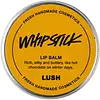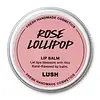What's inside
What's inside
 Key Ingredients
Key Ingredients

No key ingredients
 Benefits
Benefits

 Concerns
Concerns

 Ingredients Side-by-side
Ingredients Side-by-side

Butyrospermum Parkii Butter
Skin ConditioningPrunus Amygdalus Dulcis Oil
Skin ConditioningBeeswax
Emulsion StabilisingHoney
HumectantOlea Europaea Fruit Oil
MaskingTheobroma Cacao Fruit Powder
Skin ConditioningGlycerin
HumectantTriticum Vulgare Germ Oil
EmollientAroma
Avena Sativa Kernel Meal
AbrasiveCitrus Reticulata Fruit
Skin ConditioningCitrus Aurantium Sinensis Fiber
Emulsion StabilisingVanilla Planifolia Fruit Extract
Skin ConditioningTheobroma Cacao Husk
AbrasiveLimonene
PerfumingLinalool
PerfumingAnise Alcohol
PerfumingCitral
PerfumingButyrospermum Parkii Butter, Prunus Amygdalus Dulcis Oil, Beeswax, Honey, Olea Europaea Fruit Oil, Theobroma Cacao Fruit Powder, Glycerin, Triticum Vulgare Germ Oil, Aroma, Avena Sativa Kernel Meal, Citrus Reticulata Fruit, Citrus Aurantium Sinensis Fiber, Vanilla Planifolia Fruit Extract, Theobroma Cacao Husk, Limonene, Linalool, Anise Alcohol, Citral
Theobroma Grandiflorum Seed Butter
Skin ConditioningButyrospermum Parkii Butter
Skin ConditioningRicinus Communis Seed Oil
MaskingCitrus Limon Peel
MaskingCitrus Aurantium Dulcis Peel Cera
EmollientPrunus Amygdalus Dulcis Oil
Skin ConditioningCocos Nucifera Oil
MaskingEuphorbia Cerifera Cera
AstringentCarthamus Tinctorius Seed Oil
MaskingCopernicia Cerifera Wax
Rosa Damascena Flower Oil
MaskingCitrus Aurantium Sinensis Fiber
Emulsion StabilisingRosa Damascena Flower Water
MaskingCinnamal
PerfumingCitral
PerfumingCitronellol
PerfumingGeraniol
PerfumingLimonene
PerfumingLinalool
PerfumingAroma
Theobroma Grandiflorum Seed Butter, Butyrospermum Parkii Butter, Ricinus Communis Seed Oil, Citrus Limon Peel, Citrus Aurantium Dulcis Peel Cera, Prunus Amygdalus Dulcis Oil, Cocos Nucifera Oil, Euphorbia Cerifera Cera, Carthamus Tinctorius Seed Oil, Copernicia Cerifera Wax, Rosa Damascena Flower Oil, Citrus Aurantium Sinensis Fiber, Rosa Damascena Flower Water, Cinnamal, Citral, Citronellol, Geraniol, Limonene, Linalool, Aroma
 Reviews
Reviews

Alternatives
Ingredients Explained
These ingredients are found in both products.
Ingredients higher up in an ingredient list are typically present in a larger amount.
Aroma refers to an ingredient, or mixture of ingredients, that impart or mask a flavor.
The name is slightly confusing. This is because INCI associates aroma with flavor instead of smell.
Here is the official definition from the The International Cosmetic Ingredient Dictionary and Handbook:
“Aroma is a term for ingredient labeling used to identify that a product contains a material or combination of materials normally added to a cosmetic to produce or to mask a particular flavor.”
INCI shows the only purpose of aroma to be "flavouring".
However, due to regulation differences, some companies may use aroma in place of parfum.
In Canada, this ingredient only has to be listed in concentrations above 1%.
Learn more about AromaThis ingredient is also known as shea butter. It is an effective skin hydrator and emollient.
Emollients help soothe and soften your skin. It does this by creating a protective film on your skin. This barrier helps trap moisture and keeps your skin hydrated. Emollients may be effective at treating dry or itchy skin.
Shea butter is rich in antioxidants. Antioxidants help fight free-radicals, or molecules that may harm the body. It is also full of fatty acids including stearic acid and linoleic acid. These acids help replenish the skin and keep skin moisturized.
While Shea Butter has an SPF rating of about 3-4, it is not a sunscreen replacement.
Shea butter may not be fungal acne safe. We recommend speaking with a professional if you have any concerns.
Learn more about Butyrospermum Parkii ButterCitral is a fragrance and used to add a lemon-like scent to products. It is both naturally found in plants and created synthetically. In plants, it is commonly occurring in lemon myrtle, lemongrass, lemon tea-tree, lemon verbena, and other citruses.
The EU mandates Citral be listed separately as a fragrance. It is a known allergen and may cause contact dermatitis. Citral can also used as a masking ingredient.
The term 'fragrance' is not regulated in many countries. In many cases, it is up to the brand to define this term. For instance, many brands choose to label themselves as "fragrance-free" because they are not using synthetic fragrances. However, their products may still contain ingredients such as essential oils that are considered a fragrance.
The term 'citral' is a collective term for two geometric isomers: geranial/Citral A and neral/Citral B.
Learn more about CitralWe don't have a description for Citrus Aurantium Sinensis Fiber yet.
Limonene is a fragrance that adds scent and taste to a formulation.
It's found in the peel oil of citrus fruits and other plants such as lavender and eucalyptus. The scent of limonene is generally described as "sweet citrus".
Limonene acts as an antioxidant, meaning it helps neutralize free radicals.
When exposed to air, oxidized limonene may sensitize the skin. Because of this, limonene is often avoided by people with sensitive skin.
The term 'fragrance' is not regulated in many countries. In many cases, it is up to the brand to define this term. For instance, many brands choose to label themselves as "fragrance-free" because they are not using synthetic fragrances. However, their products may still contain ingredients such as essential oils that are considered a fragrance.
Learn more about LimoneneLinalool is a fragrance and helps add scent to products. It's derived from common plants such as cinnamon, mint, citrus, and lavender.
Like Limonene, this ingredient oxidizes when exposed to air. Oxidized linalool can cause allergies and skin sensitivity.
This ingredient has a scent that is floral, spicy tropical, and citrus-like.
Learn more about LinaloolPrunus Amygdalus Dulcis Oil comes from the sweet almond, a tree native to Iran. This oil has no fragrance and is non-volatile.
Almonds contain healthy fats, vitamins, and minerals. It is a rich source of Vitamin E, a great antioxidant and skin conditioning ingredient. Sweet almond oil contains fatty acids such as linolenic acid and triglycerides.
The content of sweet almond oil makes it a great emollient; it can help soften and hydrate your skin. Emollients create a barrier over your skin to trap moisture in. Sweet almond oil has antioxidant properties.
Those with an almond allergy should be careful of this ingredient and speak with a professional about using it in your skincare.
This ingredient may not be fungal-acne safe.
Learn more about Prunus Amygdalus Dulcis Oil